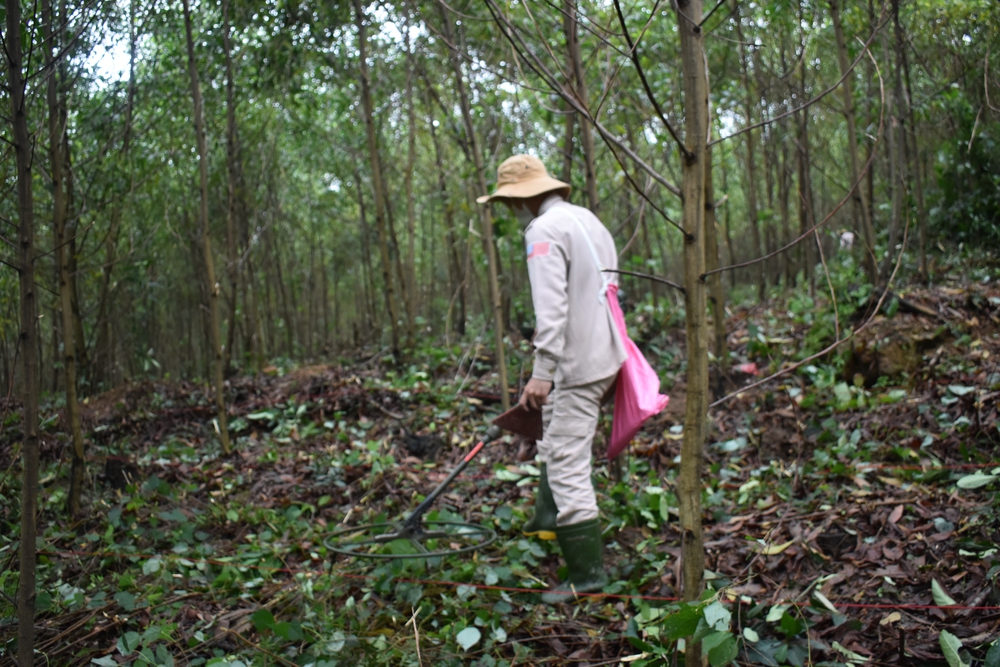50 years after the end of the Vietnam war, explosive ordnance still puts lives at risk and holds communities back.
Lý
Lý stands outside her home in Quán Ngang village, central Vietnam. 25 years ago, this land was full of landmines.
The area was a US base in the Vietnam war. It was heavily contaminated by landmines and other explosive ordnance.
“Many people died here before because of accidents and explosions from landmines and other unexploded ordnance. My father would hear noises and run to check I was okay.”
After MAG began operations in Vietnam in 1999, the area where Lý’s house now stands was the first area cleared by our teams. Now, several people live and work in safety on this land.
Lý used to be a farmer, a job that filled her with fear of standing on something dangerous. She joined MAG in 2001 and has worked there ever since.
“I was scared at first but was trained by experienced people. Everyone in my family trusts MAG and I knew the training would be good."
She still works as a deminer now and can pay for her three children to go to school with her wage.
Her hope is that MAG says in Vietnam for as long as possible so that more land can be cleared, and more people made to feel safe to live and farm.
Vân
Vân (pictured right) and his younger cousin thought they had spotted a fish in a nearby river near their home in Xuân Viên village.
The item they had spotted was in fact a mortar. The head of the village had seen the group of young, curious boys playing with something that looked dangerous when he was out walking. Thanks to MAG’s community liaison efforts, he knew the hotline number to ring to alert MAG about a suspicious item.
Our call out team came the following day to safely remove the item.
We're working in Vietnam, and around the world, so that children can be curious without fear of losing a limb, or their life.
Thanks to our team, dangerous items are located and safely destroyed – many of them planted 50 years ago and no less powerful than during the Vietnam war.
Đông
Imagine getting soil delivered for your garden, only to find it has a 60mm unexploded bomb in it from a war that finished 50 years ago.
That’s what happened to Đông, who lives in an area of Vietnam that experienced heavy bombing during the war, as well as ground fighting. The Quang Tri citadel, located only a few km away, was the site of an 81-day battle in 1972.
After pouring out the soil only to find a potentially explosive weapon tumble out too, Đông
called our team, who arrived to assess the item and figure out how to safely remove it.
Huy, team leader, coordinated his team of four deminers and a medic to assess the item. After confirming it was safe to move, he carried it to the van where, cushioned with sandbags for safety, it would remain until the planned detonation of the days finds at a controlled demolition site.
Dung
Dung is a Community Liaison Officer with our team in Vietnam. She delivers explosive ordnance risk education to community members in Quang Tri province, one of the areas worst affected by aerial artillery during the Vietnam war.
The aim of these sessions is to ensure that communities living in areas contaminated by unexploded bombs better understand how to stay safe. Our teams encourage members of the community to report dangerous items in the right way, and never to touch them. During sessions, Dung will lead games and activities with villagers to reinforce safety messages, and keep people engaged.

For many, landmines or minefields conjure up the image of a wide expanse of land, marked with flags to highlight danger.
Around the world, our teams work to clear any areas contaminated with landmines, cluster bombs or other explosive remnants of war.
There was heavy fighting in this area during the Vietnam war, with projectiles and other weapons used.
Once the war finished and people came back to live in the area, many explosive items were found. There have been 12 accidents in this village alone – resulting in 6 deaths and 9 injuries.
In Vietnam, the team are currently working to clear this area of forest around Tân Diên village. There are 170 families living close by, and since the team started clearance work earlier this year, they have already found 13 cluster bombs, and 11 other pieces of unexploded ordnance.
After clearance, the land will be handed back to the community so they can use the land and the forest for agriculture.
For more information about our work in Vietnam, click here.





